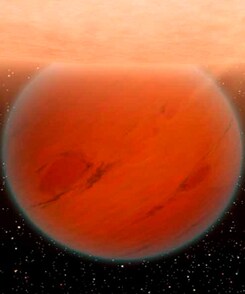Exoplanet
- All
- News
- Videos
- Web Stories
-

The Most Exciting Exoplanet Discoveries of 2025: Know the Strange Worlds Scientists Have Found
- Sunday December 28, 2025
- Written by Gadgets 360 Staff
Astronomers marked a milestone year as confirmed exoplanets surpassed 6,000 in 2025. Discoveries ranged from planets orbiting two suns to worlds losing their atmospheres or forming in real time. The findings reshaped ideas about how planets form, survive, and evolve across the Milky Way.
-
 www.gadgets360.com
www.gadgets360.com
-

Planet-Eating Stars Offer a Glimpse Into Earth’s Fate as the Sun Nears Its Final Stages
- Monday December 22, 2025
- Written by Gadgets 360 Staff
Astronomers studying aging Sun-like stars have found strong evidence that stars consume their closest planets as they evolve. Using data from NASA’s TESS mission, researchers observed fewer planets around older stars, suggesting worlds are destroyed over time. The findings offer a realistic preview of Earth’s fate billions of years from now.
-
 www.gadgets360.com
www.gadgets360.com
-

NASA Uncovers Mysterious Exoplanet Where Carbon Clouds Can Form Diamonds
- Monday December 22, 2025
- Science | Edited by Srishti Singh Sisodia
The distant planet appears to be in the shape of a lemon as the pulsar's intense gravity stretches the planet.
-
 www.ndtv.com
www.ndtv.com
-

Hubble Captures Rare Collision in Nearby Planetary System, Revealing Violent Planet Formation
- Friday December 19, 2025
- Written by Gadgets 360 Staff
Astronomers using NASA’s Hubble Space Telescope have witnessed rare collisions between rocky bodies in the Fomalhaut system. The glowing debris clouds created by these impacts offer a unique glimpse into how planets form and highlight challenges in identifying true exoplanets.
-
 www.gadgets360.com
www.gadgets360.com
-

New Orbital Clues Reveal How Hot Jupiters Moved Close to Their Stars
- Tuesday December 16, 2025
- Written by Gadgets 360 Staff
Researchers reveal some hot Jupiters drifted inward smoothly through protoplanetary disks, offering clues to planetary system formation and stability.
-
 www.gadgets360.com
www.gadgets360.com
-

NASA Finds Thick Atmosphere On Rare Rocky Exoplanet
- Monday December 15, 2025
- Science | Edited by Astitva Raj
Scientists are now analysing the entire data in depth to create a complete map of the temperature around the planet and better understand the composition of its atmosphere.
-
 www.ndtv.com
www.ndtv.com
-

Webb Telescope Discovers Hidden Atmosphere on Molten Super-Earth TOI-561 b Despite Extreme Heat
- Monday December 15, 2025
- Written by Gadgets 360 Staff
NASA’s Webb Telescope detects a hidden atmosphere on ultra-hot super-Earth TOI-561 b, revealing gases above its molten surface, challenging previous assumptions about small planets surviving intense stellar radiation.
-
 www.gadgets360.com
www.gadgets360.com
-

JWST Detects Thick Atmosphere on Ultra-Hot Rocky Exoplanet TOI-561 b
- Sunday December 14, 2025
- Written by Gadgets 360 Staff
Astronomers using the James Webb Space Telescope have discovered compelling evidence of a thick atmosphere surrounding TOI-561 b, an ultra-hot rocky exoplanet orbiting its star every 11 hours. Despite extreme radiation and molten surface conditions, the planet appears cooler than expected, suggesting heat-redistributing atmospheric winds and volati...
-
 www.gadgets360.com
www.gadgets360.com
-

Top Scientific Discoveries Of 2025: A Year of Quantum Leaps And Cosmic Revelations
- Thursday December 11, 2025
- Offbeat | Edited by Ritu Singh
Here's a look at scientific discoveries and breakthroughs that made headlines in 2025, spanning space, biology, ecology, and fundamental physics.
-
 www.ndtv.com
www.ndtv.com
-

TRAPPIST-1e Methane Signal Likely False, Webb Data Suggests Airless Planet
- Thursday December 11, 2025
- Written by Gadgets 360 Staff
The TRAPPIST-1 planetary system, located about 39 light-years from Earth, hosts seven rocky worlds orbiting a cool red dwarf star. While several of these Earth-sized planets lie in the star’s habitable zone, new observations from the James Webb Space Telescope suggest their atmospheres may be too thin to support life. Earlier hints of methane aro...
-
 www.gadgets360.com
www.gadgets360.com
-

Nancy Grace Roman Space Telescope Fully Assembled, Launch Planned for 2026–2027
- Monday December 8, 2025
- Written by Gadgets 360 Staff
NASA has successfully completed the full assembly of the Nancy Grace Roman Space Telescope, marking a major milestone for the next-generation infrared observatory. With its powerful wide-field camera and advanced coronagraph, Roman is expected to transform our understanding of dark energy, galaxy formation, and exoplanets once it launches later thi...
-
 www.gadgets360.com
www.gadgets360.com
-

Misaligned Exoplanet Is Challenging How We Think Solar Systems Form
- Friday December 5, 2025
- Written by Gadgets 360 Staff
Astronomers studying the dwarf-star system TOI-3884b have uncovered a striking anomaly: the planet’s orbit is sharply misaligned with its star’s rotation. Using multicolour transit observations, researchers detected repeated starspot-crossing events that revealed the planet passes over cooler regions on the stellar surface. Follow-up monitoring...
-
 www.gadgets360.com
www.gadgets360.com
-

James Webb Space Telescope Spots an Exoplanet Losing Its Atmosphere in a Huge Helium Stream
- Thursday December 4, 2025
- Written by Gadgets 360 Staff
Astronomers using NASA’s James Webb Space Telescope have observed a massive helium cloud escaping from the super-puff exoplanet WASP-107b, marking the first direct detection of such atmospheric loss. Webb’s infrared data reveal an enormous exosphere nearly ten times the planet’s radius, with helium streaming both ahead of and behind the plane...
-
 www.gadgets360.com
www.gadgets360.com
-

NASA’s Nancy Grace Roman Space Telescope Surpassing Expectations Even Before Launch, Reveals Research
- Tuesday November 25, 2025
- Written by Gadgets 360 Staff
NASA’s upcoming Roman Space Telescope is expected to measure seismic waves in over 300,000 red giant stars, far greater than early predictions. These signals will help scientists better understand exoplanet systems and the Milky Way’s ancient core. Researchers say Roman’s natural survey design enables this breakthrough even before the telesco...
-
 www.gadgets360.com
www.gadgets360.com
-

The Most Exciting Exoplanet Discoveries of 2025: Know the Strange Worlds Scientists Have Found
- Sunday December 28, 2025
- Written by Gadgets 360 Staff
Astronomers marked a milestone year as confirmed exoplanets surpassed 6,000 in 2025. Discoveries ranged from planets orbiting two suns to worlds losing their atmospheres or forming in real time. The findings reshaped ideas about how planets form, survive, and evolve across the Milky Way.
-
 www.gadgets360.com
www.gadgets360.com
-

Planet-Eating Stars Offer a Glimpse Into Earth’s Fate as the Sun Nears Its Final Stages
- Monday December 22, 2025
- Written by Gadgets 360 Staff
Astronomers studying aging Sun-like stars have found strong evidence that stars consume their closest planets as they evolve. Using data from NASA’s TESS mission, researchers observed fewer planets around older stars, suggesting worlds are destroyed over time. The findings offer a realistic preview of Earth’s fate billions of years from now.
-
 www.gadgets360.com
www.gadgets360.com
-

NASA Uncovers Mysterious Exoplanet Where Carbon Clouds Can Form Diamonds
- Monday December 22, 2025
- Science | Edited by Srishti Singh Sisodia
The distant planet appears to be in the shape of a lemon as the pulsar's intense gravity stretches the planet.
-
 www.ndtv.com
www.ndtv.com
-

Hubble Captures Rare Collision in Nearby Planetary System, Revealing Violent Planet Formation
- Friday December 19, 2025
- Written by Gadgets 360 Staff
Astronomers using NASA’s Hubble Space Telescope have witnessed rare collisions between rocky bodies in the Fomalhaut system. The glowing debris clouds created by these impacts offer a unique glimpse into how planets form and highlight challenges in identifying true exoplanets.
-
 www.gadgets360.com
www.gadgets360.com
-

New Orbital Clues Reveal How Hot Jupiters Moved Close to Their Stars
- Tuesday December 16, 2025
- Written by Gadgets 360 Staff
Researchers reveal some hot Jupiters drifted inward smoothly through protoplanetary disks, offering clues to planetary system formation and stability.
-
 www.gadgets360.com
www.gadgets360.com
-

NASA Finds Thick Atmosphere On Rare Rocky Exoplanet
- Monday December 15, 2025
- Science | Edited by Astitva Raj
Scientists are now analysing the entire data in depth to create a complete map of the temperature around the planet and better understand the composition of its atmosphere.
-
 www.ndtv.com
www.ndtv.com
-

Webb Telescope Discovers Hidden Atmosphere on Molten Super-Earth TOI-561 b Despite Extreme Heat
- Monday December 15, 2025
- Written by Gadgets 360 Staff
NASA’s Webb Telescope detects a hidden atmosphere on ultra-hot super-Earth TOI-561 b, revealing gases above its molten surface, challenging previous assumptions about small planets surviving intense stellar radiation.
-
 www.gadgets360.com
www.gadgets360.com
-

JWST Detects Thick Atmosphere on Ultra-Hot Rocky Exoplanet TOI-561 b
- Sunday December 14, 2025
- Written by Gadgets 360 Staff
Astronomers using the James Webb Space Telescope have discovered compelling evidence of a thick atmosphere surrounding TOI-561 b, an ultra-hot rocky exoplanet orbiting its star every 11 hours. Despite extreme radiation and molten surface conditions, the planet appears cooler than expected, suggesting heat-redistributing atmospheric winds and volati...
-
 www.gadgets360.com
www.gadgets360.com
-

Top Scientific Discoveries Of 2025: A Year of Quantum Leaps And Cosmic Revelations
- Thursday December 11, 2025
- Offbeat | Edited by Ritu Singh
Here's a look at scientific discoveries and breakthroughs that made headlines in 2025, spanning space, biology, ecology, and fundamental physics.
-
 www.ndtv.com
www.ndtv.com
-

TRAPPIST-1e Methane Signal Likely False, Webb Data Suggests Airless Planet
- Thursday December 11, 2025
- Written by Gadgets 360 Staff
The TRAPPIST-1 planetary system, located about 39 light-years from Earth, hosts seven rocky worlds orbiting a cool red dwarf star. While several of these Earth-sized planets lie in the star’s habitable zone, new observations from the James Webb Space Telescope suggest their atmospheres may be too thin to support life. Earlier hints of methane aro...
-
 www.gadgets360.com
www.gadgets360.com
-

Nancy Grace Roman Space Telescope Fully Assembled, Launch Planned for 2026–2027
- Monday December 8, 2025
- Written by Gadgets 360 Staff
NASA has successfully completed the full assembly of the Nancy Grace Roman Space Telescope, marking a major milestone for the next-generation infrared observatory. With its powerful wide-field camera and advanced coronagraph, Roman is expected to transform our understanding of dark energy, galaxy formation, and exoplanets once it launches later thi...
-
 www.gadgets360.com
www.gadgets360.com
-

Misaligned Exoplanet Is Challenging How We Think Solar Systems Form
- Friday December 5, 2025
- Written by Gadgets 360 Staff
Astronomers studying the dwarf-star system TOI-3884b have uncovered a striking anomaly: the planet’s orbit is sharply misaligned with its star’s rotation. Using multicolour transit observations, researchers detected repeated starspot-crossing events that revealed the planet passes over cooler regions on the stellar surface. Follow-up monitoring...
-
 www.gadgets360.com
www.gadgets360.com
-

James Webb Space Telescope Spots an Exoplanet Losing Its Atmosphere in a Huge Helium Stream
- Thursday December 4, 2025
- Written by Gadgets 360 Staff
Astronomers using NASA’s James Webb Space Telescope have observed a massive helium cloud escaping from the super-puff exoplanet WASP-107b, marking the first direct detection of such atmospheric loss. Webb’s infrared data reveal an enormous exosphere nearly ten times the planet’s radius, with helium streaming both ahead of and behind the plane...
-
 www.gadgets360.com
www.gadgets360.com
-

NASA’s Nancy Grace Roman Space Telescope Surpassing Expectations Even Before Launch, Reveals Research
- Tuesday November 25, 2025
- Written by Gadgets 360 Staff
NASA’s upcoming Roman Space Telescope is expected to measure seismic waves in over 300,000 red giant stars, far greater than early predictions. These signals will help scientists better understand exoplanet systems and the Milky Way’s ancient core. Researchers say Roman’s natural survey design enables this breakthrough even before the telesco...
-
 www.gadgets360.com
www.gadgets360.com
























